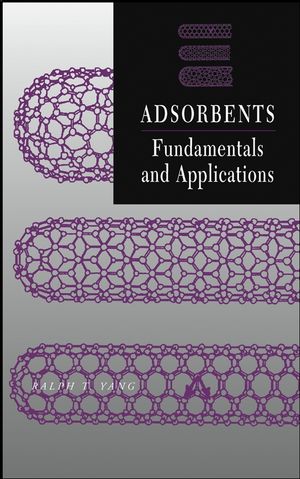Adsorbents: Fundamentals and ApplicationsISBN: 978-0-471-29741-3
Hardcover
424 pages
May 2003
 This is a Print-on-Demand title. It will be printed specifically to fill your order. Please allow an additional 10-15 days delivery time. The book is not returnable.
|
||||||
Preface xi
1 Introductory Remarks 1
1.1. Equilibrium Separation and Kinetic Separation 2
1.2. Commercial Sorbents and Applications 3
1.3. New Sorbents and Future Applications 6
References 7
2 Fundamental Factors for Designing Adsorbent 8
2.1. Potential Energies for Adsorption 8
2.2. Heat of Adsorption 10
2.3. Effects of Adsorbate Properties on Adsorption: Polarizability (α), Dipole Moment (μ), and Quadrupole Moment (Q) 11
2.4. Basic Considerations for Sorbent Design 12
2.4.1. Polarizability (α), Electronic Charge (q), and van der Waals Radius (r) 12
2.4.2. Pore Size and Geometry 13
References 16
3 Sorbent Selection: Equilibrium Isotherms, Diffusion, Cyclic Processes, and Sorbent Selection Criteria 17
3.1. Equilibrium Isotherms and Diffusion 18
3.1.1. Langmuir Isotherms for Single and Mixed Gases 18
3.1.2. Potential Theory Isotherms for Single and Mixed Gases 20
3.1.3. Ideal Adsorbed Solution Theory for Mixture and Similarities with Langmuir and Potential Theories 22
3.1.4. Diffusion in Micropores: Concentration Dependence and Predicting Mixed Diffusivities 23
3.2. Temperature Swing Adsorption and Pressure Swing Adsorption 27
3.2.1. Temperature Swing Adsorption 28
3.2.2. Pressure Swing Adsorption 30
3.3. Simple Criteria for Sorbent Selection 40
References 49
4 Pore Size Distribution 54
4.1. The Kelvin Equation 54
4.2. Horv´ath–Kawazoe Approach 55
4.2.1. The Original HK Slit-Shaped Pore Model 57
4.2.2. Modified HK Model for Slit-Shaped Pores 60
4.2.3. Modified Model for Cylindrical Pores 68
4.3. The Integral Equation Approach 74
References 76
5 Activated Carbon 79
5.1. Formation and Manufacture of Activated Carbon 79
5.2. Pore Structure and Standard Tests for Activated Carbon 82
5.3. General Adsorption Properties 84
5.4. Surface Chemistry and Its Effects on Adsorption 86
5.4.1. Effects of Surface Functionalities on Gas Adsorption 89
5.5. Adsorption from Solution and Effects of Surface Functionalities 92
5.5.1. Adsorption from Dilute Solution (Particularly Phenols) 93
5.5.2. Effects of Surface Functionalities on Adsorption 99
5.6. Activated Carbon Fibers 104
5.6.1. Adsorption Isotherms 109
5.7. Carbon Molecular Sieves 109
5.7.1. Carbon Deposition Step 114
5.7.2. Kinetic Separation: Isotherms and Diffusivities 115
5.7.3. Carbon Molecular Sieve Membranes 117
References 123
6 Silica Gel, MCM, and Activated Alumina 131
6.1. Silica Gels: Preparation and General Properties 131
6.2. Surface Chemistry of Silicas: The Silanol Groups 134
6.3. The Silanol Number (OHnm−1) 135
6.4. MCM-41 139
6.5. Chemical Modification of Silicas and Molecular Imprinting 141
6.6. Activated Alumina 146
6.7. Activated Alumina as Special Sorbents 150
References 154
7 Zeolites and Molecular Sieves 157
7.1. Zeolite Types A, X, and Y 158
7.1.1. Structure and Cation Sites of Type A Zeolite 158
7.1.2. Structure and Cation Sites of Types X and Y Zeolites 160
7.1.3. Examples of Molecular Sieving 161
7.2. Zeolites and Molecular Sieves: Synthesis and Molecular Sieving Properties 164
7.2.1. Synthesis of Zeolites A, X, and Y 164
7.2.2. Organic Additives (Templates) in Synthesis of Zeolites and Molecular Sieves 165
7.3. Unique Adsorption Properties: Anionic Oxygens and Isolated Cations 173
7.4. Interactions of Adsorbate with Cations: Effects of Cation Site, Charge, and Ionic Radius 175
7.4.1. Cation Sites 175
7.4.2. Effects of Cation Sites on Adsorption 180
7.4.3. Effects of Cation Charge and Ionic Radius 183
References 187
8 π-Complexation Sorbents and Applications 191
8.1. Preparation of Three Types of Sorbents 192
8.1.1. Supported Monolayer Salts 193
8.1.2. Ion-Exchanged Zeolites 197
8.1.3. Ion-Exchanged Resins 201
8.2. Molecular Orbital Theory Calculations 202
8.2.1. Molecular Orbital Theory—Electronic Structure Methods 202
8.2.2. Semi-Empirical Methods 203
8.2.3. Density Functional Theory Methods 203
8.2.4. Ab Initio Methods 204
8.2.5. Basis Set 205
8.2.6. Effective Core Potentials 205
8.2.7. Model Chemistry and Molecular Systems 206
8.2.8. Natural Bond Orbital 207
8.2.9. Adsorption Bond Energy Calculation 208
8.3. Nature of π-Complexation Bonding 208
8.3.1. Understanding π-Complexation Bond through Molecular Orbital Theory 209
8.3.2. π-Complexation Bonds with Different Cations 212
8.3.3. Effects of Different Anions and Substrates 213
8.4. Bulk Separations by π-Complexation 216
8.4.1. Deactivation of π-Complexation Sorbents 216
8.4.2. CO Separation by π-Complexation 216
8.4.3. OlefinParaffin Separations 219
8.4.4. AromaticsAliphatics Separation 220
8.4.5. Possible Sorbents for Simulated Moving-Bed Applications 222
8.5. Purification by π-Complexation 223
8.5.1. Removal of Dienes from Olefins 224
8.5.2. Removal of Aromatics from Aliphatics 226
References 227
9 Carbon Nanotubes, Pillared Clays, and Polymeric Resins 231
9.1. Carbon Nanotubes 231
9.1.1. Catalytic Decomposition 233
9.1.2. Arc Discharge and Laser Vaporization 241
9.1.3. Adsorption Properties of Carbon Nanotubes 243
9.2. Pillared Clays 253
9.2.1. Syntheses of PILCs 253
9.2.2. Micropore Size Distribution 256
9.2.3. Cation Exchange Capacity 258
9.2.4. Adsorption Properties 260
9.2.5. PILC and Acid-Treated Clay as Supports 262
9.3. Polymeric Resins 264
9.3.1. Pore Structure, Surface Properties, and Applications 266
9.3.2. Comparisons of Resins and Activated Carbon 269
9.3.3. Mechanism of Sorption and Gas-Phase Applications 271
References 273
10 Sorbents for Applications 280
10.1. Air Separation 280
10.1.1. 5A and 13X Zeolites 282
10.1.2. Li-LSX Zeolite 283
10.1.3. Type X Zeolite with Alkaline Earth Ions 288
10.1.4. LSX Zeolite Containing Ag (AgLiLSX) 289
10.1.5. Oxygen-Selective Sorbents 296
10.2. Hydrogen Purification 303
10.3. Hydrogen Storage 305
10.3.1. Metal Hydrides 306
10.3.2. Carbon Nanotubes 308
10.4. Methane Storage 321
10.5. OlefinParaffin Separations 326
10.5.1. Sorbents 326
10.5.2. PSA Separations 328
10.5.3. Other Sorbents 334
10.6. NitrogenMethane Separation 334
10.6.1. Clinoptilolites 336
10.6.2. ETS-4 341
10.6.3. PSA Simulation: Comparison of Sorbents 344
10.7. Desulfurization of Transportation Fuels 344
10.7.1. Fuel and Sulfur Compositions 347
10.7.2. Sorbents Studied or Used 349
10.7.3. π-Complexation Sorbent 350
10.8. Removal of Aromatics from Fuels 361
10.9. NOx Removal 363
References 371
Author Index 383
Subject Index 403



